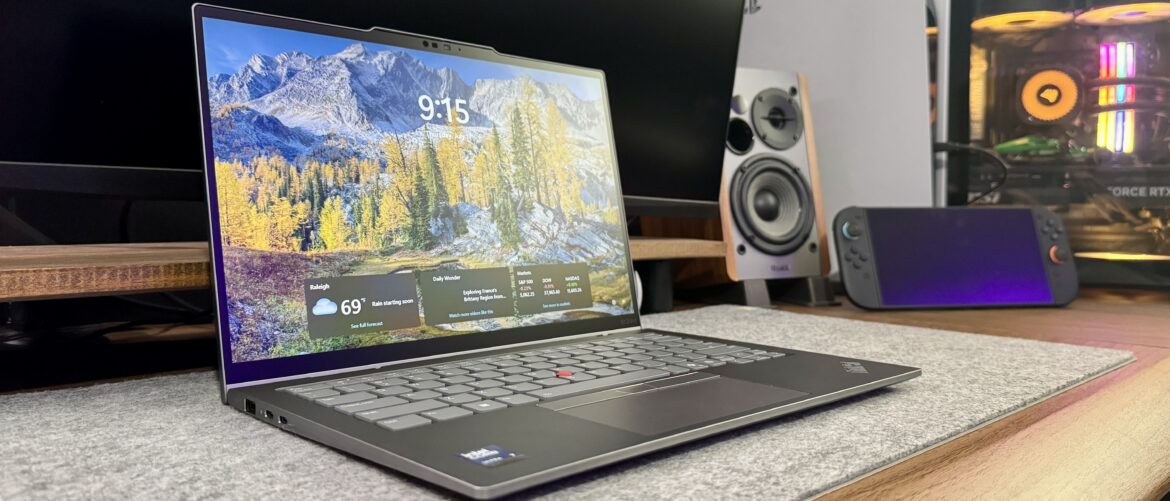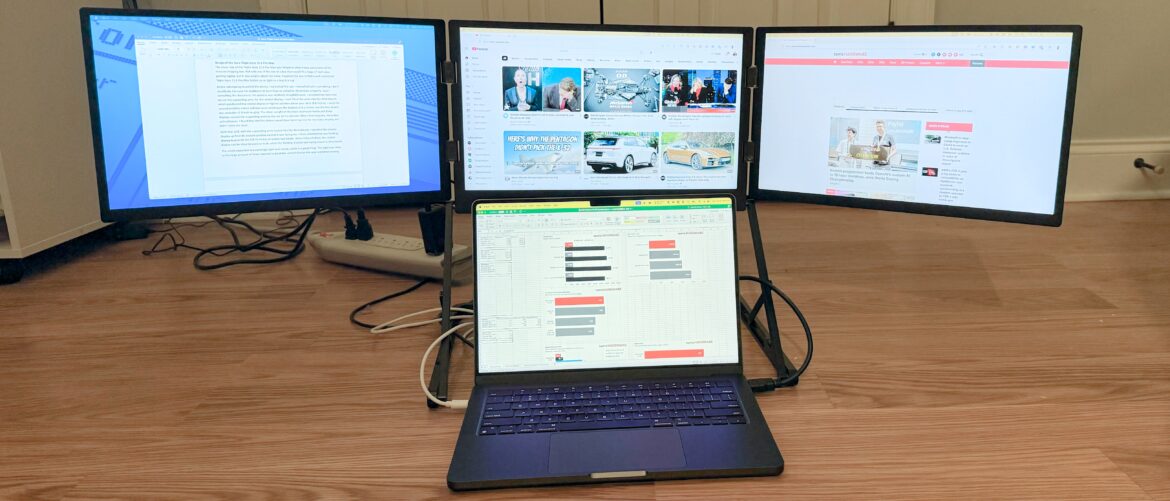Why you can trust TechRadar
We spend hours testing every product or service we review, so you can be sure you’re buying the best. Find out more about how we test.
The Lenovo ThinkPad X1 2-in-1 Gen 10 Aura Edition is a convertible two-in-one laptop well-suited to both business and creative tasks.
It’s a highly portable machine, measuring 0.31 in – 0.64 in x 12.31 in x 8.57in and with a starting weight of 2.97lb (1.35kg). As I’d expect from a true ThinkPad – even a 2-in-1 model – it’s robustly built and ideal for home and office working.
As an Aura Edition laptop, it’s an AI PC running on an Intel Core Ultra chip which, according to Lenovo “accelerates your AI experience” without being a drag on the battery. Whether that’s a plus or a minus in your book will vary. In my experience it was…fine. But I’m not the world’s biggest AI user anyway.
But as a self-confessed ThinkPad fan, I was excited to check out the overall feel and performance.
- Lenovo ThinkPad X1 2-in-1 (Gen 10) Aura Edition (14-inch 512GB) at Amazon for $1,759.99
Lenovo ThinkPad X1 2-in-1 Gen 10 Aura Edition: Price & availability
Prices for the laptop start from $1892 / £1820 (currently discounted from £2250 at time of review).
At that price, the US version of the machine comes loaded with Windows 11 Home running on the Intel Core Ultra 5 226V, 16GB RAM, and 512GB M.2 2280 PCIe Gen4 SSD.
In the UK, the base model runs W11 Home on the Intel Core Ultra 7 258V chip, 32GB RAM, and 512GB M.2 2280 PCIe Gen5 SSD.
You can also spec-up the machine with up to an Intel Core Ultra 7 268V vPro processor, 2TB SSD, and Windows 11 Pro operating system.
Either way, the base model 14in IPS touchscreen display panel has a resolution of 1920 x 1200, with Anti-Glare. It hits 100% sRGB, has a brightness of 500 nits, and a 60Hz refresh rate.
There are two other screen options, too – either the business-oriented display with its ePrivacy filter, which is otherwise identical to the base model. Or the more complex 2.8K OLED Low Blue Light display with HDR 500 True Black with 100% DCI-P3, 500 nits, VRR 30-120Hz, making it the better pick for creators.
The ThinkPad X1 2-in-1 Gen 10 Aura Edition is available from Lenovo US and Lenovo UK, as well as online retailers.
Lenovo ThinkPad X1 2-in-1 Gen 10 Aura Edition: Design & features
(Image credit: Collin Probst // Future)
Specs
As reviewed:
CPU: Intel Core Ultra 7 258V
RAM: 32GB
GPU: Integrated Intel Arc 140V GPU (16GB)
Storage: 1TB
Display: 14in OLED
Brightness: 500 nits
Refresh rate: 30-120Hz
Color gamut: 100% DCI-P3
Ports & connectivity: 2x USB-A, 2x USB-C Thunderbolt 4, 1x Nano SIM, 1x HDMI 2.1, 1x audio jack, 1x Kensington Nano Security slot, Bluetooth, Wi-Fi 7
Operating system: Windows 11 Pro
The look and feel of the X1 2-in-1 is distinctly ThinkPad – I found it robust in hand thanks to its aluminum chassis, which boasts MIL-STD-810H construction. Not exactly a true rugged laptop, then, but durable enough for the most hardened commuters. Besides the silvery accents, the main body is a stylish space grey that I thought looked professional without being boring.
The 14in screen has a thin bezel that sits behind the glass, with an elevated notch where the camera sits. The camera itself is 5MP, comes complete with physical privacy shutter, and supports Windows Hello for a passwordless sign-in.
Along the right-hand side is a USB-A and two USB-C Thunderbolt 4 ports, and a Nano SIM slot. To the left, there’s another USB-A port, as well as HDMI 2.1 port, audio jack, a Kensington Nano Security slot, and a discrete power button that sits flush with the frame. In a world where laptop makers are gradually stripping back connectivity, I find this array generous enough, and I didn’t feel the immediate need to hook up a laptop docking station. Another bonus here is the support for Wi-Fi 7, perfect for future-proofing connectivity.
Now, I’m a big champion of ThinkPad laptops (I use the T14s on a daily basis, but I’ve been a fan since I first got my trusty old T431s). In my experience, they easily offer the best typing experience compared to other laptop brands. Alright, the new Lenovo models may lack the key travel of the older IBM ThinkPads (1.5mm vs 1.8mm), but even still, they’re a joy to use.
In this regard, I was a little wary of trying out X1 2-in-1 Gen 10, as some older X1 laptops had previously used a keyboard with a stubby 1.35mm travel depth. Lenovo has, thankfully, done away with that – here, you get the same 1.5mm backlit board you’ll find on the T-series ThinkPads. As such, using this for long writing sessions is a total breeze.
However, I spotted a few differences here compared to your more traditional business laptops. Of course, there’s the iconic red Trackpoint, but there’s also a fingerprint scanner for signing in without a password and beside it, a dedicated Microsoft Copilot button – clicking this unlocks the AI assistant, while granting easy access to all the usual Office apps.
Interestingly, Lenovo has switched the Fn and Ctrl keys around here, bringing it in line with most keyboards. Older ThinkPads place the Fn key to the left, rather than the right, and I have to change this using the Lenovo Vantage app.
Lenovo ThinkPad X1 2-in-1 Gen 10 Aura Edition: Display
(Image credit: Collin Probst // Future)
My review model featured an OLED screen at 2880 x 1800 resolution with 60-120Hz refresh rate. Colors are vivid and bright, near-perfect in reproduction due to the 100% DCI-P3 gamut. For those looking for a general laptop for photo editing as well as productivity tasks, this is a pretty safe bet, I found.
The laptop operates in four ways – laptop, tablet, tent, and presentation mode, and all four work very well. I experienced no issues here at all, with the screen orientation changing swiftly and without lag when I switched from one configuration to the next. The movement feels sturdy and smooth, and pleasingly there’s no additional play to the 360-degree hinges.
What I didn’t like, however, was how reflective the screen was. Turn off the laptop and it’s like staring into a black mirror. That might not be a deal-breaker for some, but it certainly gave me pause and if you’re going to be using this outside or in direct sunlight, you’ll want to crank up the brightness to mitigate it as much as possible.
As a touchscreen device, this unit also included a stylus, which magnetically clamps to the right side of the screen. Using this in tablet mode was a total joy. Input was instant and the whole experience felt smooth.
Lenovo ThinkPad X1 2-in-1 Gen 10 Aura Edition: Performance
(Image credit: Collin Probst // Future)
I experienced no issues when using the laptop – running Microsoft’s Office suite, browsing the internet, opening many, many, many, many tabs in Chrome, at this level, nothing seemed to slow down this machine.
Under heavier workloads, there is a tendency for the X1 to run a little warm, and there, I did experience some minor slowing. But even, the impact felt negligible and it’s unlikely to prove an issue for professionals using this for general business tasks.
For a convertible business laptop, then, I found it well-specced and impressively powerful enough for day-to-day operations. Ok, it won’t deliver the same performance you’ll find from a mobile workstation or gaming laptop, but that’s not what it’s been designed for.
Lenovo ThinkPad X1 2-in-1 Gen 10 Aura Edition: Battery life
One of the stand-out areas with the X1 2-in-1 Gen 10 Aura Edition is the battery life. The machine is rocking a 57Whr battery, which is hardly massive, but acceptable. Don’t let that fool you, though, because battery life is surprisingly spectacular.
The device itself is rated for up to 20.2 hours when benchmarked using MobileMark 25, according to Lenovo. But this assumes minimal use. Streaming video playback should net up to 16.3 hours. For those using this laptop on the go, it’s positively perfect.
Lenovo ThinkPad X1 2-in-1 Gen 10 Aura Edition: Final verdict
Image 1 of 2
(Image credit: Collin Probst // Future)(Image credit: Collin Probst // Future)
Overall, I enjoyed my time with the Lenovo ThinkPad X1 2-in-1 Gen 10 Aura Edition – whether I was using it as a tablet or laptop.
It’s more than capable of handling the usual suite of business apps and software, and here, the laptop performs brilliantly. Everything feels smooth, responsive, and efficient, making it a good pick for those who prize productivity above all else.
True, it’s not the most powerful around, it’s expensive for what it is, and I’m still not a fan of the glossy screen, but all told, there’s little else to complain about.
Couple that durable design with a good port selection, excellent battery life, and a neat, multi-use design, and you have one of the best 2-in-1 laptops for professionals around.
Should I buy the Lenovo ThinkPad X1 2-in-1 Gen 10 Aura Edition?
(Image credit: Collin Probst // Future)Swipe to scroll horizontally
Attributes
Notes
Rating
Design
Convertible, durable, and distinctly ThinkPad in style
⭐⭐⭐⭐⭐
Performance
Perfect for office duties as well as lighter weight creative tasks
⭐⭐⭐⭐⭐
Price
A steeper cost than I’d like, but par for the course with a business laptop
⭐⭐⭐⭐
For more productivity performance, we tested the best business computers and the best business tablets.
Lenovo ThinkPad X1 2-in-1 (Gen 10) Aura Edition: Price Comparison



